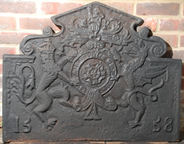-
646
Description: Arched rectangular shape; fillet edging; bell-flower column repeated on each side; at bottom, central rectangular panel, fillet edged, enclosing outstretched wings; above, intertwined leaves in figure-of-eight, enclosing a crown at the top.
Notes: This fireback incorporates features of the ‘Dutch’ style but within an English form.
- Decoration tags:
- rectangular with round arch (shape)
- fillet (edging)
- whole carved pattern
- heraldic
- plants
Manufactured: in the mid- to late-17th century in England.
Current location: Eastgate House, High Street, Rochester, Kent, England.
Museum number: A3484 (part of the Rochester Guildhall Museum museum group)
- Attached to series:
- Miscellaneous pattern firebacks
-
660
Description: Rectangular; plain plate; central, vertical cross-hilt dagger stamp; left side, fleur de lys stamp repeated five times, irregularly arranged in three rows, two above and below and one in the middle; right side, fleur de lys stamp repeated six times, four in a star above two in a row.
Notes: The dagger (length approx. 35cm), seen on two other firebacks (no. 595 and no. 1100), may have beeen of Italian manufacture. The form of the fleurs-de-lys identifies this fireback as one of the ‘Royal’ series, a large group bearing heraldic stamps.
- Decoration tags:
- rectangular (shape)
- none (edging)
- simple stamps
- carved stamps
- heraldic
- objects
Manufactured: in the mid-16th century in the Weald area of England.
Current location: Hole Park, Rolvenden, Kent, England.
- Attached to series:
- Knife & Dagger stamp firebacks
- Royal series
-
1147
Description: Rectangular shape; triple fillet moulded edging (top and sides); overpressed stamp, repeated three times (top centre and below, to left and right) of a crowned rose within a circular garter, each with the initials ER to left and right respectively; lower centre, the initials IC.
Notes: The rose and crown stamp bears striking similarities to rose and crown designs used to mark some bronze cannon of the Tudor period. The initials ER could refer to Edward VI (1547-53) or Elizabeth I (1558-1603). The initials IC most probably relate to the person for whom the fireback was made.
Inscription: ER [thrice] / I C
- Decoration tags:
- rectangular (shape)
- triple fillet (edging)
- carved stamps
- individual letters
- heraldic
- royal
- text
Manufactured: in the mid- to late-16th century in the Weald area of England.
Current location: in private hands, Rolvenden, Kent, England.
- Attached to series:
- Miscellaneous royal firebacks
- Miscellaneous stamp firebacks
-
890
Description: Canted rectangle; cavetto moulded edging (top and sides); single horizontal fillet below canted corners and vertical fillet parallel to each side, dividing the fireback into two side panels, two top corner panels, top panel and main central panel; corner panels, ‘daisy’ plant stamp; top panel, date between ‘daisy’ stamps, between initials in triad at each end; side panels, swirling foliage stamp repeated each side above a fleur-de-lys, above initial 'I' on left and 'B' on right; centre panel, stamp of ‘Indian’ smoking a pipe at top left, stamp of seated ‘gentleman’ smoking a pipe and holding another, at top right; below each, a seated monkey stamp, that on the left seated facing right, its paws in front of it and its tail below, that on the right seated facing left, its tail drawn across its chest.
Notes: The IB initials are identical to those on similar firebacks dated between 1703 and 1721, probably indicating the same founder. The number 3 of the date and the fleur-de-lys on the lower left side have been over-pressed showing the backs of the stamps. The use of stamps relating to tobacco smoking may suggest an origin near Bristol, the main entry port for the tobacco trade at that time.
Inscription: IES [triad] 1703 IES [triad] / I B
- Decoration tags:
- rectangular with canted top corners (shape)
- fillet (edging)
- carved stamps
- heraldic
- text
- animals
- humans
- plants
Manufactured: in 1703 in the Forest of Dean area of England.
Current location: Greys Court, Rotherfield Greys, Oxfordshire, England.
Museum number: 196857 (part of the National Trust museum group)
- Attached to series:
- IB series
- Date & initials firebacks
-
670
Description: Arched rectangular shape; cavetto edging; three ostrich feathers issuing from a royal coronet; a blank motto banner below; the initials bottom left, above banner.
Notes: The badge of the Prince of Wales; perhaps cast during the Commonwealth period.
Copies of this fireback are known.
Inscription: IL
- Decoration tags:
- rectangular with round arch (shape)
- cavetto (edging)
- whole carved pattern
- individual letters
- heraldic
- text
Manufactured: in the mid-17th century in the Weald area of England.
Current location: Rottingdean Grange, The Green, Rottingdean, East Sussex, England.
(part of the Brighton Museum museum group)
- Attached to series:
- Prince of Wales firebacks
- Small cavetto series
-
679
Description: Arched rectangular shape; cavetto moulding all round; spreading oak tree, with leaves and acorns, filling the whole plate; three royal crowns, one at the top of the tree, the other two symmetrically on the ends of branches towards the top corners; initials CR towards the bottom corners, the remaining inscription on a scroll across the base.
Notes: The design is derived from the celebrated occasion when Charles II evaded his pursuers by hiding in an oak tree at Boscobel House, near Wolverhampton, following the final Royalist defeat at the battle of Worcester in 1651. This popular fireback has been copied frequently.
Copies of this fireback are known.
Inscription: C THE ROYALL OAK R
- Decoration tags:
- rectangular with round arch (shape)
- cavetto (edging)
- whole carved pattern
- heraldic
- pictorial
- historical
- text
- plants
Manufactured: in the mid-17th century in England.
Current location: Saffron Walden Museum, Saffron Walden, Essex, England.
Museum number: 1899-2 (part of the Saffron Walden Museum museum group)
Citation: Butterfield, W. R., 19 Jan 1935, 'Charles II Fireback', Hastings and St Leonards Observer.
Citation: Butterfield, W. R., 1916, 'Old Wealden Firebacks', The Connoisseur, 46, pp. 197-209.
- Attached to series:
- Commemorative firebacks
-
1031
Description: Rectangular; astragal and fillet edging; two heater-shaped shields side by side, with a stag trippant crest above centre.
Notes: The dexter shield: quarterly first and fourth - Mostyn baronet - Gules a saracen's head erased proper wreathed about the temples sable and argent; second and third, within a bordure a fess fusily (or three lozenges in fess); a baronet's inescutcheon in the centre chief. The sinister shield - Sale - Argent on a bend cotised three gryphons' heads erased. Crest (Mostyn), a stag trippant proper.
Arms: Left: Mostyn with unknown quartering; right: Sal, Sale, Salle or Salley
- Decoration tags:
- rectangular (shape)
- astragal & fillet (edging)
- carved stamps
- heraldic
- armorial
- animals
- humans
Manufactured: in the 19th century in England.
Current location: in private hands, Saxtead, Suffolk, England.
- Attached to series:
- Personal armorial firebacks
-
1081
Description: Arch-shaped, the arch consisting of eight, straight, ovolo-moulded sections; longer ovolo-moulded pieces form the lower sides of the fireback; in the centre a circular garter enclosing the Tudor arms of England; above, a crown; the date was carved on a single stamp and placed below left of the crown.
Notes: From other examples it is apparent that the crown is formed from a separate stamp to the shield and garter. Formerly at the Anchor Inn, Hartfield, Sussex; later at the Carnegie Science Center, Pittsburgh, PA, it was deaccessioned in 2003 from the Carnegie Museum of Natural History in Pittsburgh and sold at auction by Skinner, Inc. of Marlborough, MA. Cropped illustration from Schubert 1950.
Inscription: 1589 / HONI SOIT qVI MAL I PANSE
Arms: Tudor royal
- Decoration tags:
- carved stamps
- date stamp
- heraldic
- armorial
- royal
- text
Manufactured: in 1589 in the Weald area of England.
Current location: not known.
- Attached to series:
- 1589 series
- Tudor royal armorial firebacks
-
368
Description: Canted rectangle; twisted rope edging (top and sides); Tudor royal shield within a Garter, supported by lion and dragon stamps, a crown above, between separate ‘E’ and ‘R’ stamps; fleur de lys stamp irregularly repeated four times below right and to left of lion.
Notes: The shield, garter and crown stamps appear on many firebacks, usually with left-facing lion and greyhound supporters; the presence of the shield and crown indicate the fireback is derived from the same source; the supporter stamps, which are over-pressed, are clearly derived from blocks intended to represent standing models. Formerly at Kirby Frith Hall, Leicestershire. Illustration from Schubert, 1957, pl. 7.
Inscription: HONE SOYT qVEY MAL Y PENSE
Arms: Tudor royal - Edward VI or Elizabeth I
- Decoration tags:
- rectangular with canted top corners (shape)
- rope (edging)
- carved stamps
- individual letters
- heraldic
- armorial
- royal
- text
Manufactured: in the mid- to late-16th century possibly at Pounsley Furnace, Framfield in the Weald area of England.
Current location: Newarke Houses, Leicester, Leicestershire, England.
Museum number: H.101.1930.0 (part of the Leicester City Museums museum group)
-
682
Description: Rectangular, with detached pediment joined by mirrored S-shaped scrolls; fillet edging with scalloping on inside edge (top and sides of rectangle, and pediment, only); central Tudor rose with surrounding garter, crowned lion and dragon supporters, surmounted by a helmet, mantling and crowned lion passant crest; initials, ER, separated by crest; initials, TP, in top corners of rectangle; ‘date’ split between bottom corners.
Notes: Stylistically of the late 16th or very early 17th centuries, the date is absent from some versions, and is likely to have been added spuriously to later recastings, of which this is one, the style of the numerals being identical to a series of firebacks cast in 1648-58.
Copies of this fireback are known.
Inscription: E R / T P / 1558
- Decoration tags:
- rectangular with detached pediment (shape)
- scalloped fillet (edging)
- whole carved pattern
- individual numbers
- heraldic
- royal
- text
Manufactured: in the mid-17th century possibly at Tintern Furnace in the Forest of Dean area of Wales.
Current location: in private hands, Sedlescombe, East Sussex, England.
- Attached to series:
- Miscellaneous royal firebacks
- 1640-50s Dean series
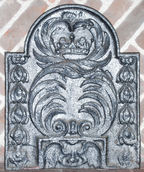
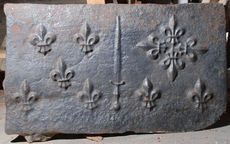
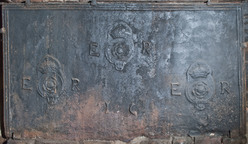
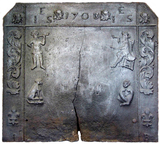
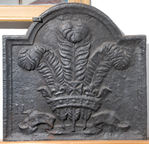
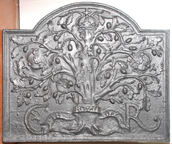
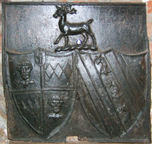
.jpg)
 01.jpg)
